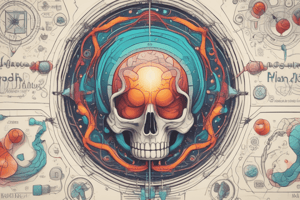Podcast
Questions and Answers
What defines pain as a subjective experience?
What defines pain as a subjective experience?
- Pain thresholds can vary due to genetics and psychology. (correct)
- Everyone experiences pain with the same intensity.
- Pain is always an indication of injury.
- Pain always has a specific cause.
Which type of pain can develop after the resolution of acute pain?
Which type of pain can develop after the resolution of acute pain?
- Neuropathic Pain
- Chronic Pain (correct)
- Psychogenic Pain
- Acute Pain
What is a common characteristic of acute pain?
What is a common characteristic of acute pain?
- It results from psychological factors only.
- It is usually long-lasting and persistent.
- It is not associated with any physical cause.
- It is typically linked to a specific injury or condition. (correct)
Which of the following is a potential condition associated with chronic pain?
Which of the following is a potential condition associated with chronic pain?
Which of the following may cause neuropathic pain?
Which of the following may cause neuropathic pain?
What factors can influence an individual's experience of pain?
What factors can influence an individual's experience of pain?
Which of the following statements about chronic pain is incorrect?
Which of the following statements about chronic pain is incorrect?
Which of the following is NOT a typical source of acute pain?
Which of the following is NOT a typical source of acute pain?
What is usually activated in response to noxious stimuli?
What is usually activated in response to noxious stimuli?
Which psychological effect is often associated with noxious stimuli?
Which psychological effect is often associated with noxious stimuli?
What is the response of nociceptors to mechanical damage?
What is the response of nociceptors to mechanical damage?
Which type of nociceptors are activated by thermal stimuli?
Which type of nociceptors are activated by thermal stimuli?
What is a common characteristic of psychological impacts due to noxious stimuli?
What is a common characteristic of psychological impacts due to noxious stimuli?
How do nociceptors detect harmful stimuli?
How do nociceptors detect harmful stimuli?
What is a typical response to treatment for patients with nociceptive pain?
What is a typical response to treatment for patients with nociceptive pain?
Which type of stimuli is detected by polymodal nociceptors?
Which type of stimuli is detected by polymodal nociceptors?
What is a primary characteristic of fentanyl's pharmacokinetics?
What is a primary characteristic of fentanyl's pharmacokinetics?
Which of the following routes of administration is NOT applicable for fentanyl?
Which of the following routes of administration is NOT applicable for fentanyl?
What is the primary reason for fentanyl's high liability for abuse and addiction?
What is the primary reason for fentanyl's high liability for abuse and addiction?
Which statement accurately describes the metabolism of fentanyl?
Which statement accurately describes the metabolism of fentanyl?
What is the half-life range of fentanyl?
What is the half-life range of fentanyl?
What kind of analgesic effect does fentanyl primarily provide?
What kind of analgesic effect does fentanyl primarily provide?
Why is patient controlled infusion systems utilized for fentanyl?
Why is patient controlled infusion systems utilized for fentanyl?
What is a key feature of fentanyl when considering its lipophilicity?
What is a key feature of fentanyl when considering its lipophilicity?
What term describes the necessity to increase dosage to maintain therapeutic effects when using opioids?
What term describes the necessity to increase dosage to maintain therapeutic effects when using opioids?
What causes orthostatic hypotension in patients using opioid analgesics?
What causes orthostatic hypotension in patients using opioid analgesics?
What is a primary consequence of long-term opioid analgesic use related to the immune system?
What is a primary consequence of long-term opioid analgesic use related to the immune system?
Which adverse effect is most commonly associated with high doses of opioid analgesics?
Which adverse effect is most commonly associated with high doses of opioid analgesics?
What mechanism leads to bronchoconstriction in patients taking opioid analgesics?
What mechanism leads to bronchoconstriction in patients taking opioid analgesics?
What is the suggested approach for discontinuing opioid analgesics to avoid withdrawal symptoms?
What is the suggested approach for discontinuing opioid analgesics to avoid withdrawal symptoms?
How does opioid analgesic use affect the urinary system?
How does opioid analgesic use affect the urinary system?
What physiological change is primarily responsible for constipation as an adverse effect of opioid analgesics?
What physiological change is primarily responsible for constipation as an adverse effect of opioid analgesics?
What is primarily decreased due to the fusion of synaptic vesicles with the pre-synaptic terminal membrane?
What is primarily decreased due to the fusion of synaptic vesicles with the pre-synaptic terminal membrane?
Which enzyme's activity is inhibited by endogenous opioid peptides?
Which enzyme's activity is inhibited by endogenous opioid peptides?
An increase in which intracellular ion is crucial for the exocytosis of neurotransmitters?
An increase in which intracellular ion is crucial for the exocytosis of neurotransmitters?
What effect does the activation of inhibitory Gi-proteins have on voltage-gated calcium channels?
What effect does the activation of inhibitory Gi-proteins have on voltage-gated calcium channels?
Which statement describes the overall effect of opioid analgesics on neurotransmission?
Which statement describes the overall effect of opioid analgesics on neurotransmission?
What is the role of Protein Kinase A in the context of opioid action?
What is the role of Protein Kinase A in the context of opioid action?
Which of the following reflects a consequence of decreased cAMP levels in the neuron?
Which of the following reflects a consequence of decreased cAMP levels in the neuron?
How does the action of opioid analgesics affect the release of neurotransmitters?
How does the action of opioid analgesics affect the release of neurotransmitters?
What is the primary action of opioid receptors in modulating pain?
What is the primary action of opioid receptors in modulating pain?
What is the result of decreased voltage-gated calcium channel activity?
What is the result of decreased voltage-gated calcium channel activity?
Which process is negatively affected by the decrease in neurotransmitter release at the synaptic cleft?
Which process is negatively affected by the decrease in neurotransmitter release at the synaptic cleft?
Which molecules are considered endogenous opioid peptides?
Which molecules are considered endogenous opioid peptides?
What is the fate of synaptic vesicles when calcium ion influx is diminished?
What is the fate of synaptic vesicles when calcium ion influx is diminished?
What is a major adverse effect associated with the use of opioid analgesics?
What is a major adverse effect associated with the use of opioid analgesics?
Which outcome occurs due to the binding of neurotransmitters to post-synaptic receptors?
Which outcome occurs due to the binding of neurotransmitters to post-synaptic receptors?
Flashcards are hidden until you start studying
Study Notes
Overview of Pain
- Pain is a subjective experience tied to distressful sensory and emotional conditions.
- Sensitive to genetics, psychology, and individual experiences; perception varies among individuals.
Types of Pain
- Acute Pain: Directly linked to a specific cause, such as injury (e.g., cuts, burns) and usually temporary.
- Chronic Pain: Develops following acute pain, can result from conditions like osteoarthritis, diabetic neuropathy, and is often resistant to conventional treatments.
Major Characteristics of Pain Types
- Cause:
- Acute pain arises from identifiable injuries.
- Chronic pain persists and may develop after acute pain.
- Physiological Response:
- Acute pain activates sympathetic nervous system (increased heart rate, blood pressure).
- Chronic pain alters central nervous system sensitivity.
- Psychological Impact:
- Chronic pain can lead to anxiety and depression, affecting social relationships.
- Response to Treatment:
- Acute pain typically responds well to NSAIDs and opioids.
- Chronic pain requires a multidisciplinary approach, including physical and psychological therapies.
Nociceptors and Pain Detection
- Nociceptors are specialized receptors for detecting harmful stimuli, located on primary afferent sensory nerve fibers.
- Types of Nociceptors:
- Mechanical: Respond to tissue distortion (e.g., injuries).
- Thermal: React to extreme temperatures.
- Chemical: Detect inflammatory mediators (e.g., prostaglandins).
Mechanism of Action of Opioid Analgesics
- Opioids act primarily on opioid receptors, leading to decreased cAMP levels and reduced neurotransmitter release.
- Inhibit adenylate cyclase activity, leading to reduced calcium influx and neurotransmitter exocytosis.
- Ultimately, opioids modulate pain transmission by reducing action potential propagation.
Adverse Effects of Opioid Analgesics
- Tolerance: Requires higher doses for the same therapeutic effect over time.
- Dependence: Withdrawal symptoms occur upon abrupt cessation after long-term use.
Specific Adverse Effects
- Cardiovascular: Causes orthostatic hypotension due to histamine-induced vasodilation.
- Respiratory: Can induce bronchoconstriction through histamine activation in smooth muscles.
- Gastrointestinal: Leads to constipation by decreasing gastrointestinal motility.
- Musculoskeletal: Increases muscle tone and may cause myoclonus at high doses.
- Urinary: Results in urinary retention due to increased bladder sphincter tone.
- Immune System: May lead to immunosuppression, heightening infection risk.
- Integumentary System: Urticaria can occur from certain opioid drugs like fentanyl.
Clinical Use of Opioid Analgesics
- Administered through various routes, including intravenous and patient-controlled infusion systems.
- Highly lipid-soluble, allowing rapid onset and the ability to cross the blood-brain barrier effectively.
General Considerations
- Opioid analgesics have a high potential for abuse and addiction, particularly noted in regions with significant opioid prescription practices.
Studying That Suits You
Use AI to generate personalized quizzes and flashcards to suit your learning preferences.




